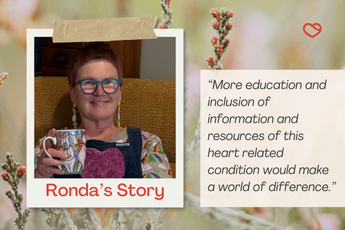Ronda’s Story: More Education Would Make a World of Difference

“More education and inclusion of information and resources of this heart related condition would make a world of difference.”
In June of 2024, Ronda was diagnosed with a dilated ascending aorta – or an ascending aortic aneurysm – at the age of 55.
The aorta is the main artery in the body, and when it becomes dilated this means that it is enlarged, causing a bulge in the aorta wall. The average aorta is around 1.5-2cm in diameter, and an aortic dilation is considered an aneurysm when it is more than 1.5 times its normal diameter. In severe cases the aneurysm can tear, causing life-threatening internal bleeding. Treatment for an aortic aneurysm can depend on its size, growth rate, and other risk factors, but surgery is generally considered if the aneurysm reaches 5cm in women.
“I was diagnosed with a dilated aorta in June 2024 at the age of 55. I had never heard of this condition. I was referred to a cardiologist who I saw first over two months later who explained that the aorta is the major artery which carries blood from the heart, and that mine had bulged in the ascending region which is between the heart and the arch. An aortic dilation is considered an aneurysm if it is more than 1.5 times its normal diameter. The scary thing about this condition is that when aortic aneurysms become large they can dissect or rupture which is a life threatening medical emergency.”
Further testing for Ronda included an echocardiogram, which is a simple non-invasive test that shows how fast or slow the heart is beating and can help diagnose heart-related issues. She also underwent a cardiac CT scan, or a coronary angiogram, which uses x-rays to provide detailed images of the arteries and is used to detect blockages or other abnormalities of the heart.
“I was then diagnosed with high blood pressure, and it was explained that blood pressure should be controlled to reduce the risk of further expansion of the aneurysm and potential rupture. Initially my aneurysm was measured by echocardiogram at 4.9cm, then measured at 4.7cm by CT.
I went to the emergency department of my local hospital with chest pain twice within a couple of months, once in January and then in March 2025, both times I had a CT scan with two vastly different measurements 4.4cm in January and 5cm in March.
In March, I was also diagnosed with reflux which explained the chest pain. I was referred back to my cardiologist who stated that he did not believe the latest measurement and that he would get it recalculated. 5cm is the diameter for which the aneurysm repair surgery – where the diseased part of the aorta is cut out and replaced – is currently considered for women.
I am well physically but mentally this has been a huge challenge. Anxiety over what size and when this major surgery might happen let alone thinking about if it ruptured is huge. This condition is often referred to as a ticking time bomb.”
Ronda’s story is a reminder to keep advocating for yourself in the face of uncertainty, and that you aren’t alone. Many people with an aortic aneurysm don’t experience any symptoms, but it can manifest in pain in the chest, back, or abdomen, coughing or wheezing, difficulty swallowing, hoarseness, shortness of breath, feeling cold or clammy, and loss of consciousness. If you have any of these symptoms, speak to your healthcare provider or call emergency services (000 in Australia).
Her Heart is here to support women at every stage of their heart health journey. Through our Find a Female Cardiologist registry, you can connect with experienced cardiologists across Australia who understand women’s unique heart health needs. Our website offers trusted, up-to-date information about heart conditions, symptoms, and risk factors. And by joining our online community, you can connect with other women, share stories, and find strength in knowing you’re not alone.
“With the help of Her Heart I was able to find an expert cardiologist for a second opinion in an attempt to answer the “what size” question, this has really helped. The size is currently 4.5 cm and I have confidence that this is a correct and accurate measurement.
I think there is a gap in support for women like myself who have this condition in Australia. It has certainly affected my mental health. More education and inclusion of information and resources of this heart related condition would make a world of difference.”
To hear more about Ronda’s journey, you can also check out her episode on the Sew Organised Style podcast here, and connect with her on social media @anakiequilter where she continues to advocate for women’s heart health.
